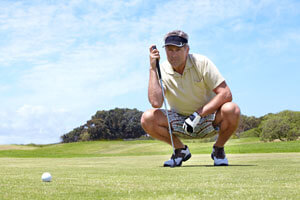Three exercises to improve your functional fitness
The first question is: What is functional fitness? Functional fitness is training your muscles to help you do everyday activities safely and more efficiently.
That sounds logical but how is that different than weight training? Functional fitness is weight training, but the exercises are specifically chosen to target multiple joints and muscle groups in each exercise. So that your muscles more efficiently work together to prevent injury.
Functional fitness exercises your muscles similar to how you use them in everyday life. For example, squats are used to help you prepare your body to better perform standing to sitting or sitting to standing movements (lowering yourself into a chair or getting out of a chair).
Whether you are just starting to exercise or need to shake up your exercise routine, here are three exercises that you should try.
Functional fitness exercises
- Squats help to strengthen the muscles needed to sit down, stand up, get off the floor and walk. Squats also help to improve hip and ankle mobility.
Stand with your feet flat on the ground, hip width apart. Begin by slowly lowing your body toward the ground by bending your knees and hips simultaneously. Make sure to keep your knees behind your toes and push your butt back. To help keep your back straight, pick a spot on the wall near the ceiling and focus on that while you complete the motion. Once you are as low as you feel comfortable, raise yourself back up to the starting position.
Modifications- Make it easier:
- Don’t lower yourself as low to the ground before returning to the starting position.
- Hold on to a railing or stationary chair to assist with balance.
- Have a chair behind you to lower down to and rest between the lowering and raising steps.
- Make it harder:
- Lower yourself closer to the ground before returning to the starting position.
- Add weights (hold dumbbells at your shoulders).
- Do one legged squats. Place one foot on a chair behind you.
- Make it easier:
- Pull ups help to improve grip strength, strengthen your back and counteract the pushing/forward bent movements of your daily life.
On a pull up bar, place hands just wider than shoulder width apart with palms facing toward you. Start with your arms straight and pull yourself up until your chin is above the bar and lower yourself back to starting position.
Modifications- Make it easier:
- Use an assisted pull-up machine, this takes some of the weight off so that you aren’t lifting your full body weight.
- Use the Lat pull down machine. This works the same muscles, but you can choose your weight and work your way up.
- Make it harder:
- Add weight by using ankle weights or a weighted vest.
- Do more repetitions.
- Use the lat pull down machine and use more weight than your body weight.
- Change your grip (further apart, closer together, palms facing away from you).
- Make it easier:
- Push-ups build upper body and core strength which helps to prevent lower back injury. Some even suggest that push-ups can help prevent shoulders from injury since they require the stabilizing muscles around the shoulder joint to work.
Starting face down on a mat, place your hands next to you in line with your chest. Keep your body in a straight line from your ankles to your shoulders while raising and lowering yourself. Remember to keep your entire body in a straight line. This will help strengthen your core muscles.
Modifications- Make it easier:
- Use the wall and do standing pushups. Stand about 1-2 feet from a wall and place your hands on the wall at chest level. Lower yourself toward the wall and push yourself away from the wall while keeping your core tight and body in a straight line.
- Use the counter. Place your hands on the edge of the counter or bench. Make sure you adjust your body so that your hands are at chest level when at lower part of the movement and push yourself up.
- Brace from the knees. Make sure to keep your back straight and your butt down (in line with your back and legs).
- Make it harder:
- Add weight by using weighted vest.
- Place your hands or feet on a stability ball.
- Place your hands on a medicine ball.
- Place your hands further out to your sides or closer in.
- Do one armed pushups.
- Place one hand on a medicine ball and complete a push up and roll it to your other hand and repeat.
- Make it easier:
